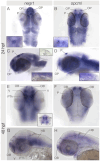The Risk Genes for Neuropsychiatric Disorders negr1 and opcml Are Expressed throughout Zebrafish Brain Development
- PMID: 38540422
- PMCID: PMC10969947
- DOI: 10.3390/genes15030363
The Risk Genes for Neuropsychiatric Disorders negr1 and opcml Are Expressed throughout Zebrafish Brain Development
Abstract
The immunoglobulin LAMP/OBCAM/NTM (IgLON) family of cell adhesion molecules comprises five members known for their involvement in establishing neural circuit connectivity, fine-tuning, and maintenance. Mutations in IgLON genes result in alterations in these processes and can lead to neuropsychiatric disorders. The two IgLON family members NEGR1 and OPCML share common links with several of them, such as schizophrenia, autism, and major depressive disorder. However, the onset and the underlying molecular mechanisms have remained largely unresolved, hampering progress in developing therapies. NEGR1 and OPCML are evolutionarily conserved in teleosts like the zebrafish (Danio rerio), which is excellently suited for disease modelling and large-scale screening for disease-ameliorating compounds. To explore the potential applicability of zebrafish for extending our knowledge on NEGR1- and OPCML-linked disorders and to develop new therapeutic strategies, we investigated the spatio-temporal expression of the two genes during early stages of development. negr1 and opcml are expressed maternally and subsequently in partially distinct domains of conserved brain regions. Other areas of expression in zebrafish have not been reported in mammals to date. Our results indicate that NEGR1 and OPCML may play roles in neural circuit development and function at stages earlier than previously anticipated. A detailed functional analysis of the two genes based on our findings could contribute to understanding the mechanistic basis of related psychiatric disorders.
Keywords: IgLON; brain; negr1; neuropsychiatric disorder; opcml; zebrafish development.
Conflict of interest statement
The authors declare no conflicts of interest. The funders had no role in the design of the study; in the collection, analyses, or interpretation of data; in the writing of the manuscript; or in the decision to publish the results.
Figures



Similar articles
-
The Role of IgLON Cell Adhesion Molecules in Neurodegenerative Diseases.Genes (Basel). 2023 Sep 28;14(10):1886. doi: 10.3390/genes14101886. Genes (Basel). 2023. PMID: 37895235 Free PMC article. Review.
-
Altered Expression Profile of IgLON Family of Neural Cell Adhesion Molecules in the Dorsolateral Prefrontal Cortex of Schizophrenic Patients.Front Mol Neurosci. 2018 Jan 29;11:8. doi: 10.3389/fnmol.2018.00008. eCollection 2018. Front Mol Neurosci. 2018. PMID: 29434535 Free PMC article.
-
Alternative Promoter Use Governs the Expression of IgLON Cell Adhesion Molecules in Histogenetic Fields of the Embryonic Mouse Brain.Int J Mol Sci. 2021 Jun 28;22(13):6955. doi: 10.3390/ijms22136955. Int J Mol Sci. 2021. PMID: 34203377 Free PMC article.
-
Promoter-Specific Expression and Genomic Structure of IgLON Family Genes in Mouse.Front Neurosci. 2017 Feb 2;11:38. doi: 10.3389/fnins.2017.00038. eCollection 2017. Front Neurosci. 2017. PMID: 28210208 Free PMC article.
-
MicroRNAs Associated with IgLON Cell Adhesion Molecule Expression.Curr Issues Mol Biol. 2024 Jul 19;46(7):7702-7718. doi: 10.3390/cimb46070456. Curr Issues Mol Biol. 2024. PMID: 39057097 Free PMC article. Review.
Cited by
-
Genetic Factors Related to the Development or Progression of Mesoamerican Endemic Nephropathy.Int J Mol Sci. 2025 May 8;26(10):4486. doi: 10.3390/ijms26104486. Int J Mol Sci. 2025. PMID: 40429630 Free PMC article. Review.
References
-
- Schofield P.R., McFarland K.C., Hayflick J.S., Wilcox J.N., Cho T.M., Roy S., Lee N.M., Loh H.H., Seeburg P.H. Molecular Characterization of a New Immunoglobulin Superfamily Protein with Potential Roles in Opioid Binding and Cell Contact. EMBO J. 1989;8:489–495. doi: 10.1002/j.1460-2075.1989.tb03402.x. - DOI - PMC - PubMed
-
- Funatsu N., Miyata S., Kumanogoh H., Shigeta M., Hamada K., Endo Y., Sokawa Y., Maekawa S. Characterization of a Novel Rat Brain Glycosylphosphatidylinositol-Anchored Protein (Kilon), a Member of the IgLON Cell Adhesion Molecule Family. J. Biol. Chem. 1999;274:8224–8230. doi: 10.1074/jbc.274.12.8224. - DOI - PubMed
Publication types
MeSH terms
Substances
Grants and funding
LinkOut - more resources
Full Text Sources
Medical
Molecular Biology Databases

